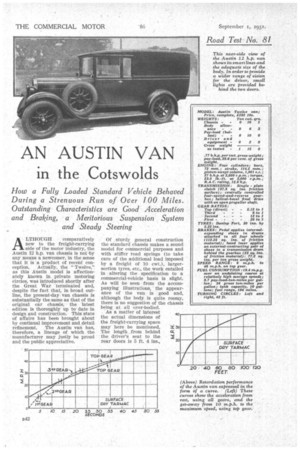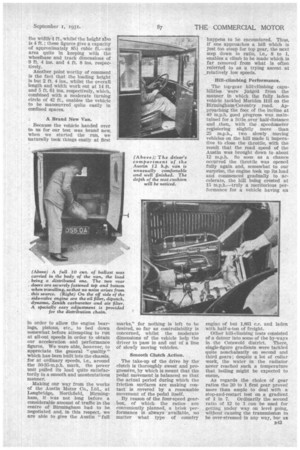AN AUSTIN VAN in the Cotswolds
Page 60

Page 61

Page 62

If you've noticed an error in this article please click here to report it so we can fix it.
How a Fully Loaded Standard Vehicle Behaved During a Strenuous Run of Over 1.00 Miles. Outstanding Characteristics are Good Acceleration and Braking, a Meritorious Suspension System
and Steady Steering
LTIIOUGH comparatively new to the freight-carrying side of the motor industry, the Austin 12 h.p. van chassis is not -by any means a newcomer, in the sense that it is a product of recent con
ception. Actually, the "Twelve,' as this Austin model is affectionately known in. private motoring circles, was introduced shortly after the Great War terminated and, despite the fact that, in broad outline, the present-day van chassis is substantially the same as that of the original ear chassis, the latest edition is thoroughly up to date.in design and construction. This.state of affairs has been brought about by continual improvement and detail refinement. The Austin van has, therefore, a lineage of which the manufacturer may justly be proud and the public appreciative.
Of _sturdy general construction the standard chassis makes a sound model for commercial purposes and with stiffer road springs (to take care of the additional load imposed by a freight of 10 cwt.), largersection tyres, etc., the work entailed in • altering the specification to a commercial-vehicle basis is slight. As will he seen from the accompanying illustrations, the appearance of the van is good and, although the body, is quite roomy, there is no suggestion of the chassis being at all nyer-bodied. . As a matter of interest the actual dimensions of the freight-carrying space may here be mentioned. The length from behind the driver's seat to the rear doors is 5 ft. 4 ins.,
the widtir4 ft., whilst"the height also is 4 ft.; these figures give a capacity of approximately 85i• cubic ft.—an area quite in keeping with the wheelbase and track dimensions of 9 ft. 4 ins. and 4 ft. 8 ins. respectively
Another point worthy of comment is the fact that the loading height is but 2 ft. 4 ins., whilst the overall length and width work out at 14 ft. and 5 ft. 64 ins, respectively, which, combined with a moderate turning circle of 42 ft., enables the vehicle to be manceuvred quite easily in confined spaces.
A Brand New Van.
• Because the vehicle handed to us for our test was brand when we started the run, naturally took things easily at over new. we first
in order to allow the engine bearings, piston's, etc., to bed down somewhat before attempting to run at all-out speeds in order to obtain our acceleration and performance figures. We were able, however, to appreciate the general " quality " which has been built into the chassis, for at ordinary speeds, i.e., around the 30-35-m.p.h. mark, the power unit pulled its load quite satisfactorily in a smooth and unostentatious manner.
Making our way from the works of the Austin Motor Co., Ltd., at Longbridge, Northfield, Birmingham, it was not long before a considerable amount of traffic in the centre of Birmingham had to be negotiated and, in this respect, we are able to give the Austin "full marks," for nothing is left to he desired, so far as controllability is concerned, whilst the moderate dimensions of the vehicle help the driver to pass in and out of a line of slowly moving vehicles.
Smooth Clutch Action.
The take-up of the drive by the clutch is thoroughly sweet and progressive, by which is meant that the pedal movement is balanced so that the actual period during which the friction surfaces are making contact is covered by a reasonable movement of the pedal itself.
By reason of the four-speed gearbox, of which the ratios are conveniently planned, a brisk performance is always available, no matter what type of country happens to be encountered. Thus, if one approaches a hill which is just too steep for top gear, the next step down in ratio, i.e., 8 to 1, enables a climb to be made which is far removed from what is often xeferred to as a trying ascent at relatively low speeds.
Hill-climbing Performance.
The top-gear hill-climbing capabilities 'were judged from the manner in which the fully laden vehicle tackled Meriden Hill on the Birmingham-Coventry road. Approaching the foot of the incline at 40 m.p.h. good progress was maintained for a little over half-distance and _then, with the speedometer registering slightly more . than 25 m.p.h., two slowly moving vehicles on the hill made it imperative to close • the throttle, with the result that the road speed of the Austin was brought down to about 12 m.p.h. SO S0011 as a chance occurred the throttle was opened fully again and, somewhat to our surprise, the engine took up its load and commenced gradually to ac-celerate, the hill being crested at 15 m.p.h.—truly a meritorious performance for a vehicle having an engine of but 1,861 c.c. and laden with half-a-ton of freight.
Other hill-climbing tests consisted of a detour Into some of the by-ways in the Cotswold district. There, single-figure gradients were tackled quite nonchalantly on second and third gears ; despite a lot of collar work, the water in the radiator never reached such a temperature that boiling might be expected to ensue.
As regards the choice of gear ratios the 20 to 1 first gear proved more than ample to deal with a stop-and-restart test on a gradient
of 1 in 7. Ordinarily the second ratio of 12 to 1 can be used for getting under way on level going, without causing the transmission to be over-stressedin any way, but as
the gear-change is so simple there is really no necessity of this procedure. Experimentally, we used only top gear on one restart on a level road and found that the clutch, gearbox, propeller shaft and rear axle behaved perfectly, thereby demonstrating that the transmission generally is planned on thoroughly sound lines.
The steering mechanism can be summarized by saying that it is " just right?' Apart from the fact that the wheel is of a convenient size and the column is raked to a sensible angle, the ratio of handwheel to road-wheel movement is, we think, nicely balanced, whilst the castor action provided is sufficient to relieve the driver of any expenditure of energy when straightening up after a corner. Over bumpy road surfaces there is no appreciable " kick " transmitted to the wheel and, at high speeds, there is _no tendency for the front road wheels to wander.
With a van of moderate load capacity, such as this Austin model, it was thought the main work for which the vehicle is intended Is that of delivery in towns dud cities (although, naturally enough, the machine is equally suitable for long distances), so we took particular note of how quickly the driver could get under way after making a stop. To reach the normal cruising speed of 80 m.p.h. but, 19 seconds were required if the gears were handled in a reasonable manner.
A side issue, but nevertheless an important one, is the fact that both the driver and passenger can get into and out of the front compartment easily and quickly—a sine qua non in rapid delivery' work.
Efficiency of the Brakes.
As befits such a chassis, the brakes are well up to their work. Trials, which we carried out on a first-class tarmacadam road, showed that when properly adjusted the braking effort on all four wheels is nearly equal, consequently maximum efficiency is ensured. During our emergency brake tests, we were unable to lock a wheel on dry roads, whilst when negotiating wet, slippery surfaces the vehicle remained quite steady and was ' not at all .prone to skidding.
While in the hilly part of our course in the Cotswold district there was ample opportunity for us to. appreciate the effectiveness of both the pedal-operated system and the transmission brake operated by the hand lever. Both fulfil their functions quite satisfactorily.
Before concluding, mention should be made of the driver's accommodation. Seldom have we sat in a more comfortable cab, for the seat and squab are nicely upholstered and are of such dimensions that a 6-ft. driver can be seated in comfort. The facia board and controls are similar to those of Austin private cars. All the instruments are grouped Immediately in front of the driver and the dip-and-switch gear for the headlamps is conveniently placed on the steering column, above the wheel.
Summarizing our impressions of this interesting vehicle is an easy matter for we found that it had a good all-round performance and was easy to drive. With safe braking, a satisfactory fuel consumption, and a good freight-carrying capacity for its size, the machine should prove popular among operators who require a smart vehicle.




































































































